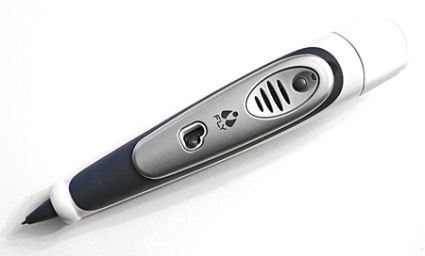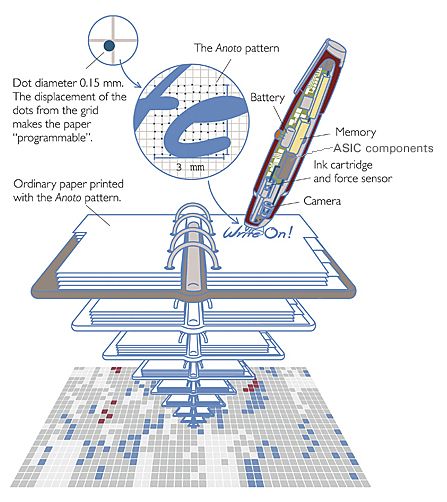Are
Pens The
Hot New
Mobile Computing
Technology?
Barry Gerber
This Pentop Computer Is No Joke
When I first heard about LeapFrog's Fly Pentop Computer it seemed like a perfect product for a half-serious half-humorous review . After all it is marketed as a toy for 'tweens (ages 8-13) and you conjure up one sort of functionality or another by writing with the pen on a piece of paper. I mean, how much could such a device actually do?

Once I got my hands on the Fly and did a little research, I discovered that this pen's no joke; it's not even half a joke. Not only is the pen pretty impressive in itself, but it's based on some very innovative technology from Sweden that is finding its way into a number of other products designed to support applications from note taking to medical prescription writing to inventorying to SMS message composition and transmission.
The Fly, running on one 1.5 V AAA battery , has this remarkable ability to morph into a number of forms including a calculator, notepad, scheduler, keyboard with rhythm section and drums, journal, math and social studies teacher and Spanish dictionary. You tell it what to do by drawing or writing on a piece of special paper called "Fly Paper." For example, you create a calculator by first drawing a letter C with a circle around it. Then you draw a rectangle to contain the calculator, add the numbers 0 through 9, a period for decimals and symbols for addition, subtraction, multiplication, subtraction and equals. A voice intelligently guides you through this process and provides feedback as you use the pen to do anything you can do on a simple calculator.
In case you think this is pretty basic stuff to pull off in a computer, let me point out that you can put each number and symbol anywhere you wish within the calculator rectangle. Your paper calculator doesn't have to look like real one. You can also change from one application to another just by moving to the piece of paper or section of a piece of paper where you have drawn the application. You can even switch between applications in the middle of a particular step. I love demonstrating this capability by penning two numbers to be added together into the calculator, but not touching the equal sign. Next I go over to the keyboard and play some notes, rhythms and drums. Finally I return to the calculator and touch equals. The voice reads the result. I'll show you how this works later on.
Because of its uniqueness and the innovation behind it, MobilityGuru presents its Editor's Choice Award to LeapFrog, manufacturer of the Fly Pentop Computer. A second Editor's Choice Award goes to the Anoto Group AB of Sweden for its pattern recognition paper and software that makes modern pen-based computing possible.
How The Fly Works
The Fly Pentop Computer depends on a number of technologies to do its thing. Most of these are inside the computer itself. The Fly uses technology from the Anoto Group AB in Sweden, a spin-off from telecommunications giant Ericsson. Anoto doesn't manufacture hardware , rather owns and licenses the specs for pen-based computer pattern recognition hardware. It also licenses the software required for pen-based computer pattern recognition. Anoto licensees who plan to produce products must see to it that required pattern recognition hardware is produced and integrated with Anoto's software. Licensees must also create or purchase hardware and software to support specific functions to be included in their pen-based computers.
The figure below is a slightly modified diagram from Anoto that shows how the technology works. Note that the Fly PenTop doesn't come with a cap as the diagram shows. Rather, the top of the device has a receptacle for plug-in application cartridges (see below). Aside from the top of the pen, the diagram is a pretty good representation of the Anoto technology as implemented by LeapFrog. Follow along on the diagram as I explain what's up inside and outside of a Fly computer .

Anoto's pen computer technology
For the Fly, LeapFrog produced an Application Specific Integrated Circuit (ASIC) that includes Anoto's optical sensing pattern recognition technology. The ASIC also includes LeapFrog's own audio and compression capabilities. The latter can be found in various forms in the company's speech-oriented products. This technology supports more than 70,000 phoneme-to-speech words that are spoken in a natural way.
The ASIC also provides CPU functionality for the device. In addition, code for all of the Fly's basic applications is stored on-board the pen computer in non-volatile memory. Plug-in cartridges support additional applications. Application cartridges also use ASIC technology and non-volatile memory. Because all basic applications are built into the pen, when you buy the pen you get a dummy cartridge.
User generated data is also stored in non-volatile memory. This data includes information about specific user drawn and implemented applications such as a calculator or keyboard.
1 2